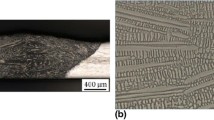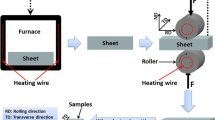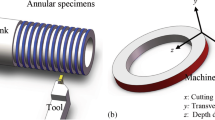Abstract
Pitting initiation and propagation at the deformation bands intersection of cold-rolled 14Cr10Mn stainless steel in acidic ferric chloride solution with a pH of 1.3 were investigated by a scanning electron microscope equipped with electron back scatter diffraction and a high-resolution transmission electron microscopy. The experimental results show that the pits with regular morphology are a sort of dislocation etch pit with strict triggering conditions. The pitting corrosion resistance of the etch pits is closely related to the orientations in the increasing order of {100}〈001〉 < {110}〈112〉 < {111}〈110〉. The pit wall will expand to the periphery along the trend of retaining the close-packed plane, leading to an increase in pit depth after the pitting initiation is triggered. We believe that hydrogen ions compete with chloride ions and preferentially adsorbed on the dislocation outcrops in the austenite around α′-martensite and form hydrogen atoms occupying vacancies to prevent chloride ions from eroding the metal matrix. The results also reveal that the vacancy bands formed by the slip of edge dislocations, and the vacancy groups formed by the dissolve of partial dislocation outcrops are patterns for triggering dislocation etch pits.







Similar content being viewed by others
References
Hariharan K, Balachandran G, Sathyaprasad M (2009) Application of cost-effective stainless steel for automotive components. Adv Manuf Process 24:1442–1452
Kim YH, Kim KY, Lee YD (2004) Nitrogen-alloyed, metastable austenitic stainless steel for automotive structural applications. Mater Manuf Process 19:51–59
Krüger L, Wolf S, Martin U, Martin S, Scheller PR, Jahn A, Weiß A (2010) The influence of martensitic transformation on mechanical properties of cast high alloyed CrMnNi-steel under various strain rates and temperatures. J Phys Conf Ser 240:012098
Lo KH, Shek CH, Lai JKL (2009) Recent developments in stainless steels. Mater Sci Eng R 65:39–104
Sedriks AJ (1979) Corrosion of stainless steels. John Wiley and sons, New York
Frankel GS (1998) Pitting corrosion of metals a review of the critical factors. J Electrochem Soc 145:2186–2198
Sedriks AJ (1986) Effects of alloy composition and microstructure on the passivity of stainless steels. Corrosion 42:376–389
Frankel GS (1998) Pitting corrosion of metals a review of the critical factors. J Electrochem Soc 145:675–685
Schmuki P, Hildebrand H, Friedrich A, Virtanen S (2005) The composition of the boundary region of MnS inclusions in stainless steel and its relevance in triggering pitting corrosion. Corros Sci 47:1239–1250
Ravi KB, Singh R, Mahato B, De PK, Bandyopadhyay NR, Bhattacharya DK (2005) Effect of texture on corrosion behavior of AISI 304L stainless steel. Mater Charact 54:141–147
Mudali UK, Shankar P, Ningshen S, Dayal RK, Khatak HS, Raj B (2002) On the pitting corrosion resistance of nitrogen alloyed cold worked austenitic stainless steels. Corros Sci 44:2183–2198
Pampillo CA (1972) Localized shear deformation in glassy metal. Scr Met 6:915–917
Nie XP, Cao QP, Wu ZF, Ma Y, Wang XD, Ding SQ, Jiang JZ (2012) The pitting corrosion behavior of shear bands in a Zr-based bulk metallic glass. Scr Mater 67:376–379
Wang YM, Zhang C, Liu Y, Chan KC, Liu L (2013) Why does pitting preferentially occur on shear bands in bulk metallic glasses? Intermetallics 42:107–111
Guo R, Tromans D, Weinberg F (1995) Pitting corrosion of passivated β-tin monocrystals. Corrosion 51:212–222
Yasuda M, Weinberg F, Tromans D (1990) Pitting corrosion of Al and Al-Cu single crystals. J Electrochem Soc 137:3708–3715
Borle WN, Bagai RK (1976) Dislocation etch pits on various crystal planes of silicon. J Cryst Growth 36:259–262
Javaid F, Bruder E, Durst K (2017) Indentation size effect and dislocation structure evolution in (001) oriented SrTiO3 Berkovich indentations: HR-EBSD and etch-pit analysis. Acta Mater 139:1–10
He Z, Zhao B, Zhu S, Chen B, Huang W, Lin L, Feng B (2017) Crystal growth and dislocation etch pits observation of chalcopyrite CdSiP2. J Cryst Growth 481:29–34
Huang W, Zhao B, Zhu S, He Z, Chen B, Zhen Z, Pu Y (2016) Low-temperature solid-state synthesis and optical properties of CdS–ZnS and ZnS–CdS alloy nanoparticles. J Alloy Compd 656:818–824
Böttcher A, Gerber T, Lücke K (2013) Determination of microtexture of initial stages of secondary recrystallisation in Fe–3 wt% Si by etch pitting. Mater Sci Technol 8:16–22
Inokuti Y, Maeda C, Ito Y (1985) Transmission kossel study of the formation of (110)[001] grains after an intermediate annealing in grain oriented silicon steel containing a small amount of Mo. Metall Trans A 16:1613–1623
Stephenson JD (2010) Some applications of charactcristic square etch pits formed on 100 surfaces of Fe–3 wt% Si crystals. Phys Stat Sol 39:89–101
Latanision RM, Opperhauser H (2013) Passivation of nickel monocrystal surfaces. Corros Eng 27:509–515
Cui JP, Hao YL, Li SJ, Sui ML, Li DX, Yang R (2009) Reversible movement of homogenously nucleated dislocations in a β-titanium alloy. Phys Rev Lett 102:045503
Shen YF, Li XX, Sun X, Wang YD, Zuo L (2012) Twinning and martensite in a 304 austenitic stainless steel. Mater Sci Eng A 552:514–522
Zhang Y, Li M, Bi H, Gu J, Chen D, Chang E, Zhang W (2018) Martensite transformation behavior and mechanical properties of cold-rolled metastable Cr-Mn-Ni-N austenitic stainless steels. Mater Sci Eng A 724:411–420
Zhang B, Wang J, Wu B, Guo XW, Wang YJ, Chen D, Zhang YC, Du K, Oguzie EE, Ma XL (2018) Unmasking chloride attack on the passive film of metals. Nat Commun 9:2559
Qiao LJ (1998) Effects of hydrogen on pitting susceptibility of type 310 stainless steel. J Chin Soc Corros Protect 54:628–633
Olson GB, Cohen M (1975) Kinetics of strain-induced martensitic nucleation. Metall Trans A 6:791–795
Murr LE, Staudhammer KP, Hecker SS (1982) Effects of strain state and strain rate on deformation-induced transformation in 304 stainless steel: part II. Microstructural study. Metall Trans A 13:627–635
Liu J, Chen C, Feng Q, Fang X, Wang H, Feng L, Jian L, Raabe D (2017) Dislocation activities at the martensite phase transformation interface in metastable austenitic stainless steel: an in situ TEM study. Mater Sci Eng A 703:236–243
Somani MC, Juntunen P, Karjalainen LP, Misra RDK, Kyröläinen A (2009) Enhanced mechanical properties through reversion in metastable austenitic stainless steels. Metall Mater Trans A 40:729–744
Acknowledgements
The authors would like to thank Shanghai Science and Technology Commission Scientific Research Project (15XD1520100) and the National Natural Science Foundation of China (Grant Nos. 51571139 and U1660205) for financial support.
Author information
Authors and Affiliations
Corresponding author
Additional information
Publisher's Note
Springer Nature remains neutral with regard to jurisdictional claims in published maps and institutional affiliations.
Rights and permissions
About this article
Cite this article
Zhang, Y., Li, M. & Bi, H. The mechanism of pitting initiation and propagation at deformation bands intersection of cold-rolled metastable stainless steel in acidic ferric chloride solution. J Mater Sci 54, 14914–14925 (2019). https://doi.org/10.1007/s10853-019-03922-w
Received:
Accepted:
Published:
Issue Date:
DOI: https://doi.org/10.1007/s10853-019-03922-w




